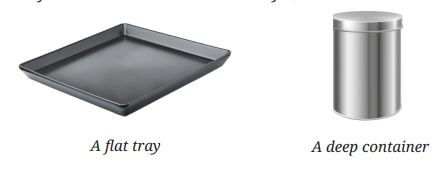Activity W 3.3
Students will get an opportunity to explore the difference between Volume and Area, through this activity.
This will be done by comparing how much space different containers occupy and how much they can hold
Material Required
Two flat trays.
Two deep containers (different shapes).
Rice or small beans or sand.
Small cups (to be taken as measuring cups).
(The teacher can try arranging one deep container with a base approximately the same as one of the trays.)
Procedure
Step 1: Observation
Show students the flat trays and deep containers (of different shapes).
Ask:
Q: What do you notice about these things (trays and containers)?ANSWER: The trays are flat and wide, while the containers are deep and can hold more things inside.
Q: How are the trays different from the deep containers?
A: Trays are shallow and only have surface space, while deep containers have depth and can store more material.
Q: Which ones do you think will hold more rice/sand? Why?
A: The deep containers will hold more rice or sand because they have more depth and space inside.
Step 2 : Measuring Area
Sprinkle a thin layer of rice or sand on the flat trays until the surface is fully covered.
(The teacher needs to ensure that there is only one layer of the rice or sand on the trays.)
Use measuring cups to measure how much rice or sand each tray holds.
Ask:
Q: Did the rice or sand cover the entire tray?A: Yes, the rice or sand covered the entire surface in a single, thin layer.
Q: Without changing the shape the rice or sand takes on the tray, would the tray be able to ‘hold’ more of it?(We cannot make a heap of rice or sand.)A: No, because a tray only has a flat surface and no depth, so it cannot hold more without spilling.
Q: How can we measure the space covered by the rice or sand?A: We can measure the area by using square units (like cm²) to cover the surface.
Q: Can you think of other examples where we use area in daily life?(for example, carpets, tiles, painting walls)?
A: Yes — laying carpets, painting walls, tiling floors, covering tables, or making posters.
Step 3: Measuring Capacity (Volume)
Measuring Capacity
Fill the deep containers with rice or sand to the top.
Use measuring cups to measure how much rice or sand each container holds.
Ask:
Q: Why do the deep containers hold more rice or sand than the trays?
A: Because the containers have depth, which allows them to store more in the same surface area.
Q: What changed when we measured volume instead of area?
A: Instead of just covering the surface, we now measured the full space inside the container, including depth.
Q: How many layers of rice or sand would we need to make the trays hold the same amount as the deep containers? Estimate.
A: It would take many thin layers (depending on the depth of the container), for example, if the container is 5 cm deep and the rice layer is 0.5 cm thick, it would take around 10 layers.Q: How is volume different from area?
A:
-
Area measures the flat surface space.
-
Volume measures the total space inside an object.
Step 4:
Making Real-world Connections
Discuss examples from real life:
Q: Why do water bottles and storage boxes have depth?
A: Because depth allows them to hold more water or items — volume is important for storage.
Q: Would a swimming pool be useful, if it only had area but no depth?A: No, because without depth, it couldn’t hold water for swimming.
Q: Do architects and builders use volume when designing rooms and buildings? How?
A: Yes, they calculate volume to make sure there is enough space for air, furniture, and people inside a room.
Reflections
Summarise that area measures surface coverage, while volume measures the total space inside an object or a container.
SUMMARY
Area measures the surface coverage of an object — it tells us how much flat space is covered, like when we lay a carpet or paint a wall.
Volume measures the total space inside an object or a container — it tells us how much material or liquid it can hold, like water in a bottle or rice in a jar.
In simple words:
👉 Area = Surface covered
👉 Volume = Space filled inside
Encourage students to think about other objects, where area and volume play a role in real life.
Let students predict, which objects in the classroom have a large area but small volume and vice versa.
Let students predict situations, where Area is used and situations, where Volume is used. Participation of Special Children—
Use lightweight containers and trays that are easy to handle.
If students have difficulty lifting or pouring, provide pre-measured cups of rice or sand so they can still participate.
Arrange the activity on lower tables or surfaces so all students, including those using wheelchairs, can comfortably access the materials.
Pair students so they can work together, allowing those with mobility challenges to observe, instruct and record findings, while their peers assist with pouring and measuring.
CONCLUSION:
Area is about measuring how much surface something covers (like the top of a tray or the floor for a carpet).
-
Volume is about measuring how much space an object can hold inside (like filling a bottle, a bucket, or a container).
- Objects with the same area can have different volumes, and vice versa.
- Area is used when covering something flat, like painting walls or laying tiles.
- Volume is used when filling something, like a water bottle, swimming pool, or a storage box.
When I sprinkled rice or sand on the flat tray, it only covered the surface — that is area. But when I filled the deep containers, they could hold much more rice because of their depth — that is volume.

No comments:
Post a Comment